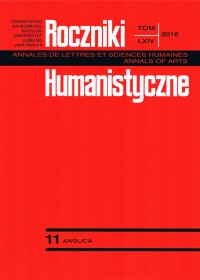/fɑɪs/, /fes/ or /feɪs/? Teachers’ phonetic accommodation of diphthongs in an L2 classroom setting
Abstract
The following paper aims to investigate whether, and if so to what extent, native speaker teachers resort to phonetic accommodation in the use of diphthongs in the classroom setting. In the course of analysis, seven native speaker teachers, each representing a different variety of British English, were recorded in two distinct contexts: classroom and natural. The recordings were used in acoustic analysis in order to gauge potential differences in F1 and F2 in each context. It was concluded that phonetic accommodation does occur in the classroom setting and the modifications of either individual segments or the whole glides can be observed, irrespective of the native accent of the user. It was found, however, that the speakers representing northern varieties of English accommodate more than those speaking with other accents. Another important observation resulting from the analysis was that some diphthongs are likely to undergo phonetic accommodation more than others. On the one end of the cline we observe the diphthong price, whereas the other end is occupied by the glides goat and cure. It is still unclear, however, whether the modifications occur consciously, thus representing a rather developed declarative knowledge of the users, or subconsciously, which would suggest an inner need to attempt to pronounce diphthongs in a standardized way.
References
Adank, Patti, Roel Smits, and Roeland Van Hou. 2004. “A comparison of vowel normalization procedures for language variation research.” Journal of the Acoustical Society of America 116(5): 3099-3107.
Babel, Molly E. 2009. Phonetic and Social Selectivity in Speech Accommodation. PhD dissertation, University of California, Berkeley.
Babel, Molly E. 2012. “Evidence for phonetic and social selectivity in spontaneous phonetic imitation.” Journal of Phonetics 40(1): 177–189.
Boersma, Paul, and David Weenink. 1992/2005. Praat: Doing phonetics by computer. www.praat.org (accessed 12.12.2016).
Brennan, Susan E., and Herbert H. Clark. 1996. “Conceptual pacts and lexical choices in conversation.” Journal of Experimental Psychology: Learning, Memory, and Cognition 22 (6): 1482–1493.
Chambers, Jack K. 1992. “Dialect acquisition.” Language 68: 673–705.
Council of Europe. 2001. Common European Framework of Reference for languages: Learning, teaching, assessment. Cambridge: Cambridge University Press.
Delvaux, Véronique, and Alain Soquet. 2007. “The influence of ambient speech on adult speech productions through unintentional imitation.” Phonetica 64(2-3): 145–173.
Evans, Bronwen G., and Paul Iverson. 2007. “Plasticity in vowel perception and production: A study of accent change in young adults.” Journal of the Acoustical Society of America 128: 3814–3826.
Ferragne, Emmanuel, and François Pellegrino. 2010. “Formant frequencies of vowels in 13 accents of the British Isles.” Journal of the International Phonetic Association 40(1): 1–34.
Goldinger, Stephen D. 1998. “Echoes of echoes? An episodic theory of lexical access.” Psychological Review 105(2): 251–279.
Jones, Daniel. 2003. Cambridge English pronouncing dictionary. 16th edition. Cambridge: Cambridge University Press.
Kraljic, Tanya, Susan E. Brennan, and Arthur G. Samuel. 2008. “Accommodating variations: Dialects, idiolects and speech processing.” Cognition 107(1): 54–81.
Lobanov, Boris. 1971. “Classification of Russian vowels spoken different listeners.” Journal of Acoustical Society of America 49: 606–608.
Mitterer, Holger, and Mirjam Ernestus. 2008. “The link between speech perception and production is phonological and abstract: Evidence from the shadowing task.” Cognition 109: 168-173.
Munro, Murray J., Tracey M. Derwing, James E. Flege. 1999. “Canadians in Alabama: a perceptual study of dialect acquisition in adults.” Journal of Phonetics 27: 385–403.
Pardo, Jennifer S. 2006. “On phonetic convergence during conversational interactions.” Journal of the Acoustical Society of America 119(4): 2382-2393.
Payne, Arvilla C. 1980. “Factors controlling the acquisition of the Philadelphia dialect by out-of-state children.” In Locating language in time and space, edited by William Labov, 179–218. New York: Academic Press.
Roeder, Rebecca. 2009. “The effects of phonetic environment on English /æ/ among speakers of Mexican heritage in Michigan.” Toronto Working Papers in Linguistics 31: 1–15.
Shephard, Carolyn A., Howard Giles, and Beth A. Le Poire. 2001. “Communication accommodation theory.” In The new handbook of language and social psychology, edited by W. Peter Robinson and Howard Giles, 33–56. New York: Wiley.
Steinbrich, Piotr. 2014. “Phonetic accommodation in an EFL classroom setting—the case of NS teachers.” In J. Szpyra-Kozłowska, E. Guz, P. Steinbrich, & R. Święciński (Eds.), Recent developments in applied phonetics, edited by Jolanta Szpyra-Kozłowska, Ewa Guz, Piotr Steinbrich, Radosław Święciński, 173–195. Lublin: Catholic University of Lublin Press.
Traunmüller, Hartmut. 1990. “Analytical expressions for tonotopic sensory scale.” Journal of the Acoustical Society of America 79: 1086–1100.
Trudgill, Peter. 1986. Dialects in contact. New York: Blackwell Publishing.
Trudgill, Peter. 2008. “Colonial dialect contact in the history of European languages: On the irrelevance of identity in new-dialect formation.” Language in Society 37: 241–280.
Upton, Clive. 2004. “Synopsis: Phonological variation in the British Isles.” In A handbook of varieties of English. Vol. 1: Phonology, edited by Edgar W. Schneider, Kate Burridge, Bernd Kortmann, Rajent Mesthrie, and Clive Upton, 1063–1074. Berlin: Mouton de Gruyter.
Wells, John C. 1982. Accents of English 2: The British Isles. Cambridge: Cambridge University Press.
Wells, John C. 2008. Longman pronunciation dictionary. 3rd edition. Harlow: Longman.
Wolfram, Walt, Phillip Carter, and Beckie Moriello. 2004. “Emerging Hispanic English: New dialect formation in the American South.” Journal of Sociolinguistics 8(3): 339–358.
Copyright (c) 2016 Roczniki Humanistyczne

This work is licensed under a Creative Commons Attribution-NonCommercial-NoDerivatives 4.0 International License.





